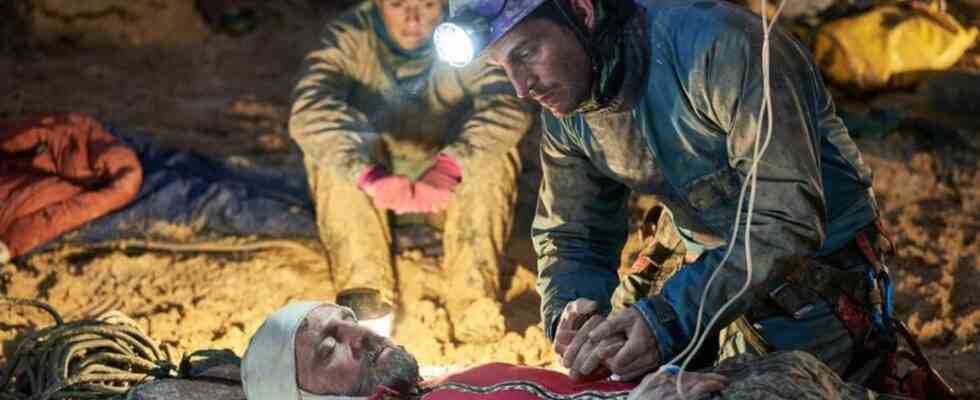criticism
“Giant thing” film: mountain rescue service “put in the wrong light”
Bernd Hellersdorf (Christoph Bach) bids farewell to the injured Josef Häberle (Roland Silbernagl) in a scene from the film “Riesending – Every hour counts”. photo
© Nikola Predovic/Senator Film Production/BR/ARD/Degeto/dpa
A researcher has an accident in Germany’s deepest cave. Hundreds of helpers can free him. The story is now being filmed in the two-part TV series “Riesending” – but it paints a bad picture of the mountain rescue service.
The two-part TV series “Giant thing – every hour counts” about the 2014 cave rescue near Berchtesgaden has been met with considerable criticism from rescue workers. Bavaria’s Interior Minister Joachim Herrmann (CSU) also spoke today. Crucial aspects would be hidden in the feature film.
The image of the mountain rescue service, which is not shown so positively in the film, does not correspond to the work of the many volunteers that can be experienced every day in mountain rescue, said Herrmann. Fiction and reality diverged significantly in many places in the film that was broadcast on ARD the day before yesterday.
The minister went on to say: “The film is not a documentary, but rather a modern fairy tale based on real events. That is entirely permissible, but in some places it gives the impression that the film also has a documentary character. In particular, what the As far as the role of the mountain rescue service is concerned, the film deviates significantly from what actually happened.”
Klaus Burger, regional manager of the Chiemgau mountain rescue service and at the time part of the operations team, said that the feedback showed that the impression was that it was a documentary. The representation does not reflect the rescue will and competence of the mountain rescuers. “The mountain rescue service is put in the wrong light, which our highly motivated volunteer women and men don’t deserve.”
At Pentecost 2014, a rockfall seriously injured a researcher in the Riesending Cave near Berchtesgaden. In a spectacular operation with more than 800 helpers – cave climbers from five countries and members of aid organizations, army, police and fire brigade – the rescue was successful.
The film produces a black and white world
In the feature film broadcast on ARD on Wednesday, for example, the mountain rescue operations manager is portrayed as hesitant, at a loss and overwhelmed. The good image of the mountain rescue service seems to interest him more than the matter.
“In no way” does the film reflect reality, says Thomas Küblbeck from the Marktschellenberg mountain rescue service, former regional manager and head of operations during the operation. The spokesman for the mountain rescue service, Roland Ampenberger, criticizes that a black and white world is being drawn at the expense of the mountain rescue service and its volunteers.
“We ask ourselves what the motivation is here and what the message of the film is ultimately supposed to be when there is a claim to reality, but at the same time an entire organization is discredited in order to create tension,” says Ampenberger. “We are concerned that the description of this rescue operation will have anything but a positive effect on the motivation of our emergency services, but especially on all volunteers from other aid organizations.”
“Film is fiction,” said director Jochen Alexander Freydank (“Toy Land”) when asked about the inglorious depiction of the mountain rescue service. The conflict “Do you want to endanger other human lives in order to save someone” is a very complex conflict. And as always with an artistic work, it is also about exaggeration.

